中国组织工程研究 ›› 2018, Vol. 22 ›› Issue (36): 5753-5759.doi: 10.3969/j.issn.2095-4344.0376
• 骨组织构建 bone tissue construction • 上一篇 下一篇
骨质疏松症和膝关节骨关节炎共病的蛋白组学分析
时 刚1,张开伟2
- (1解放军成都军区八一骨科医院,四川省成都市 610031;2贵州中医学院第一附属医院,贵州省贵阳市 550002)
Proteomics analysis of osteoporosis with knee osteoarthritis
Shi Gang1, Zhang Kaiwei2
- (1Bayi Orthopedics Hospital of Chengdu Military Region of PLA, Chengdu 610031, Sichuan Province, China; 2the First Affiliated Hospital of Guizhou University of Chinese Medicine, Guiyang 550002, Guizhou Province, China)
摘要:
文章快速阅读:
.jpg) 文题释义:
蛋白组学研究:是在蛋白质组学水平上,对生命活动的功能执行体——蛋白质进行深入系统的研究,不仅能全景式地揭示生命活动的本质,而且对研究疾病病因、病理、诊断以及治疗方法等均具有重大意义。
蛋白组学iTRAQ技术:是由AB SCIEX公司研发的一种基于体外等重同位素标记的相对与绝对定量技术。该技术利用4种或8种同位素试剂标记多肽末端氨基或赖氨酸侧链氨基基团,经高精度质谱仪串联分析,可同时比较多达8种样品之间的蛋白质表达量,是近年来定量蛋白质组学常用的高通量筛选技术。
文题释义:
蛋白组学研究:是在蛋白质组学水平上,对生命活动的功能执行体——蛋白质进行深入系统的研究,不仅能全景式地揭示生命活动的本质,而且对研究疾病病因、病理、诊断以及治疗方法等均具有重大意义。
蛋白组学iTRAQ技术:是由AB SCIEX公司研发的一种基于体外等重同位素标记的相对与绝对定量技术。该技术利用4种或8种同位素试剂标记多肽末端氨基或赖氨酸侧链氨基基团,经高精度质谱仪串联分析,可同时比较多达8种样品之间的蛋白质表达量,是近年来定量蛋白质组学常用的高通量筛选技术。
.jpg) 文题释义:
蛋白组学研究:是在蛋白质组学水平上,对生命活动的功能执行体——蛋白质进行深入系统的研究,不仅能全景式地揭示生命活动的本质,而且对研究疾病病因、病理、诊断以及治疗方法等均具有重大意义。
蛋白组学iTRAQ技术:是由AB SCIEX公司研发的一种基于体外等重同位素标记的相对与绝对定量技术。该技术利用4种或8种同位素试剂标记多肽末端氨基或赖氨酸侧链氨基基团,经高精度质谱仪串联分析,可同时比较多达8种样品之间的蛋白质表达量,是近年来定量蛋白质组学常用的高通量筛选技术。
文题释义:
蛋白组学研究:是在蛋白质组学水平上,对生命活动的功能执行体——蛋白质进行深入系统的研究,不仅能全景式地揭示生命活动的本质,而且对研究疾病病因、病理、诊断以及治疗方法等均具有重大意义。
蛋白组学iTRAQ技术:是由AB SCIEX公司研发的一种基于体外等重同位素标记的相对与绝对定量技术。该技术利用4种或8种同位素试剂标记多肽末端氨基或赖氨酸侧链氨基基团,经高精度质谱仪串联分析,可同时比较多达8种样品之间的蛋白质表达量,是近年来定量蛋白质组学常用的高通量筛选技术。摘要
背景:鉴于骨质疏松症和骨关节炎以及两者共病的发病率较高,且两者之间的关系目前尚无统一性定论,在综合分析国内外相关研究者对两者的相关性的研究方案后,趋利去弊,课题采取运用蛋白组学技术对骨质疏松症与骨关节炎两者共病的软骨组织进行研究,希望从中找出两者共病的蛋白标志物。为两者共病的相关性研究提供客观的物质基础,为防治骨质疏松症和骨关节炎提供理论依据。
目的:利用蛋白组学iTRAQ技术,对骨质疏松症、膝关节骨关节炎和骨质疏松症并膝关节骨关节炎模型的新西兰大白兔膝关节关节软骨组织进行差异蛋白定量分析,从中筛选并鉴定出骨质疏松症和骨关节炎共病的蛋白标志物。
方法:制备骨质疏松症、膝关节骨关节炎和骨质疏松症并膝关节骨关节炎动物模型,待造模成功后,提取各组动物膝关节关节软骨样本,运用蛋白组iTRAQ技术对各组样本进行蛋白组定量定性分析,对比各组样本中蛋白质组的差异性,筛选出共病组样本中与各自单病组样本中的蛋白表达量存在明显差异(差异倍数>1.2,P < 0.01)的特异性蛋白。再经查阅uniport数据库及相关文献,分析特异性蛋白的特性以及与骨质疏松症和膝关节骨关节炎的相关性,以初步鉴定出骨质疏松症和膝关节骨关节炎共病的蛋白标志物。
结果与结论:①共筛选出12个骨质疏松症和骨关节炎共病的特异性蛋白:α-2-HS糖蛋白、M型肌酸激酶、纤维蛋白原β链、纤维蛋白原γ链、血清白蛋白、维生素D结合蛋白、N-acylethanolamine酸酰胺酶、促微管聚合蛋白2、Asporin蛋白、髓鞘P0蛋白、Uncharacterized protein (G1TQR3)、Uncharacterized protein(U3KLT3);②上述12个特异性蛋白在骨质疏松症和骨关节炎共病模型组的蛋白表达量均呈显著性升高;③根据12个特异性蛋白各自的生物特性与骨质疏松症和膝骨关节炎的病因病理机制的相互联系,从中初步鉴定出8个特异性蛋白,其生物特性与骨质疏松症和膝关节骨关节炎的病因病理密切相关,初步认定为骨质疏松症和膝关节骨关节炎共病的蛋白标志物,可将其作为两者共病的物质基础进行进一步相关机制研究。
中国组织工程研究杂志出版内容重点:组织构建;骨细胞;软骨细胞;细胞培养;成纤维细胞;血管内皮细胞;骨质疏松;组织工程
中图分类号:
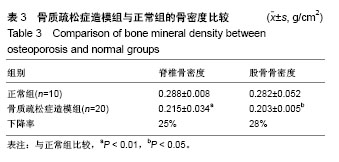
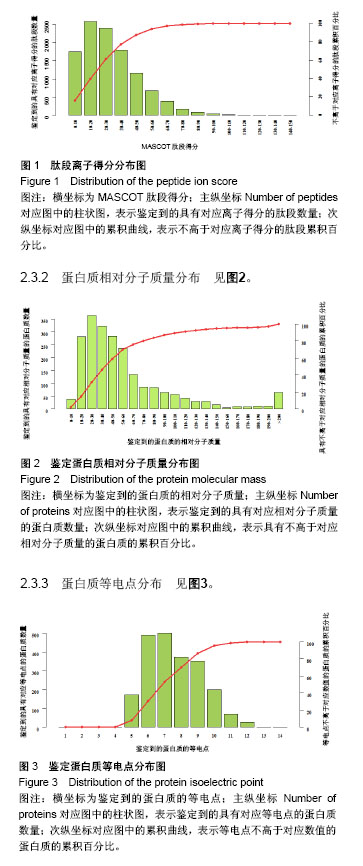
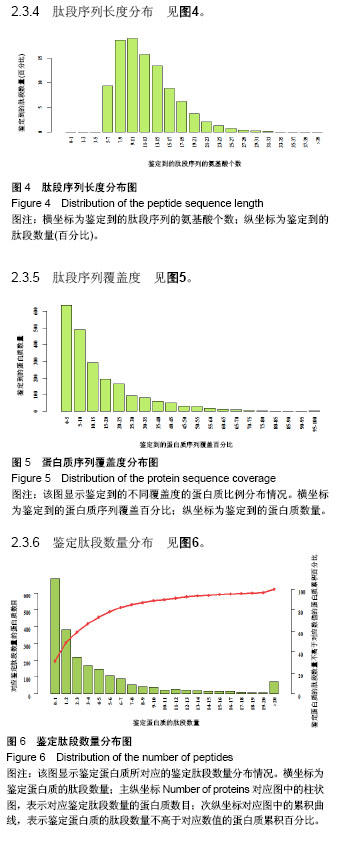
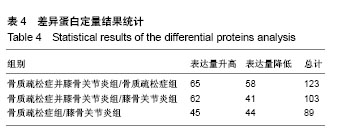
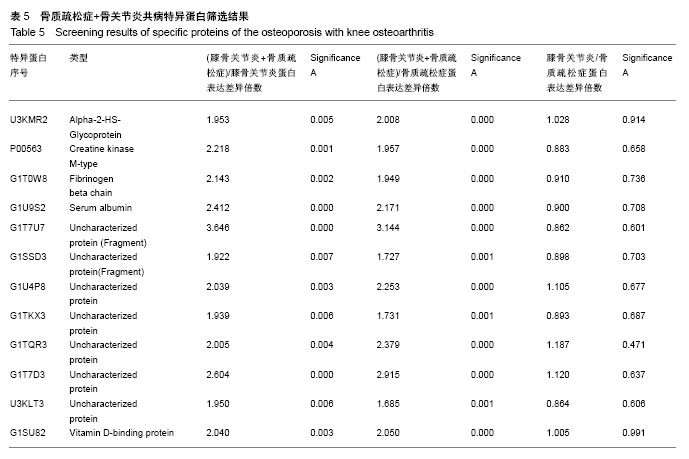
.jpg) 文题释义:
蛋白组学研究:是在蛋白质组学水平上,对生命活动的功能执行体——蛋白质进行深入系统的研究,不仅能全景式地揭示生命活动的本质,而且对研究疾病病因、病理、诊断以及治疗方法等均具有重大意义。
蛋白组学iTRAQ技术:是由AB SCIEX公司研发的一种基于体外等重同位素标记的相对与绝对定量技术。该技术利用4种或8种同位素试剂标记多肽末端氨基或赖氨酸侧链氨基基团,经高精度质谱仪串联分析,可同时比较多达8种样品之间的蛋白质表达量,是近年来定量蛋白质组学常用的高通量筛选技术。
文题释义:
蛋白组学研究:是在蛋白质组学水平上,对生命活动的功能执行体——蛋白质进行深入系统的研究,不仅能全景式地揭示生命活动的本质,而且对研究疾病病因、病理、诊断以及治疗方法等均具有重大意义。
蛋白组学iTRAQ技术:是由AB SCIEX公司研发的一种基于体外等重同位素标记的相对与绝对定量技术。该技术利用4种或8种同位素试剂标记多肽末端氨基或赖氨酸侧链氨基基团,经高精度质谱仪串联分析,可同时比较多达8种样品之间的蛋白质表达量,是近年来定量蛋白质组学常用的高通量筛选技术。